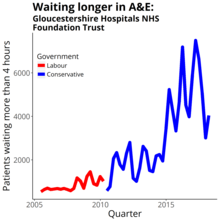Gloucestershire Hospitals NHS Foundation Trust
Gloucestershire Hospitals NHS Foundation Trust runs Gloucestershire Royal Hospital, an NHS district general hospital in Great Western Road, Gloucester, England. It serves western and southern Gloucestershire and parts of Herefordshire. It also runs Cheltenham General Hospital. The trust is currently under the leadership of chair Peter Lachecki and chief executive Deborah Lee.
| Gloucestershire Hospitals NHS Foundation Trust | |
|---|---|
| Type | NHS foundation trust |
| Established | 1 January 2002 |
| Hospitals | |
| Staff | 7,438 FTE (2018/19)[1] |
| Website | www |
History
The present organisation was formed in 2002 by a merger of Gloucestershire Royal and East Gloucestershire NHS Trusts.[2]
In 2017 the trust investigated the establishing of a subsidiary company (SubCo). On 28 February 2018 the trust board approved the recommendations which resulted in the creation of Gloucestershire Hospitals Subsidiary Company Ltd (trading as Gloucestershire Managed Services), to which 675 support staff were transferred on 1 April 2018. The intention was to achieve VAT benefits, as well as pay bill savings, by recruiting new staff on less expensive non-NHS contracts. VAT benefits arise because NHS trusts can only claim VAT back on a small subset of goods and services they buy. The Value Added Tax Act 1994 provides a mechanism through which NHS trusts can qualify for refunds on contracted out services.[3]
Performance

The Trust was highlighted by NHS England as having 3 of the 148 reported never events in the period from April to September 2013.[4]
In 2009/10 private patients from the UK and from overseas paid the trust £4.4 million, but that had dropped to £3.2 million by 2013/14.[5]
A Care Quality Commission in March 2015 found insufficient consultants in emergency departments, that A&E waiting-time targets were constantly not being met and patients were having to queue in emergency department corridors for treatment.[6]
It was put into special measures in October 2016 after failings in financial governance.[7]
References
- "Annual Report and Accounts 2018 – 2019" (PDF). Gloucestershire Hospitals NHS Foundation Trust. Retrieved 30 July 2020.
- "The Gloucestershire Hospitals and the Gloucestershire Partnership National Health Service Trusts (Establishment) and the East Gloucestershire National Health Service Trust, the Gloucestershire Royal National Health Service Trust and the Severn National Health Service Trust (Dissolution) Order 2001". legislation.gov.uk. Retrieved 30 July 2020.
- "In full: Trusts with staff transfer plans". Health Service Journal. 14 February 2017. Retrieved 15 February 2018.
- "NHS reveals 'never event' figures". Sheffield Star. 13 December 2013. Archived from the original on 17 December 2013. Retrieved 14 December 2013.
- "NHS hospitals in Gloucestershire see income from private patients drop as recession bites". Gloucestershire Echo. 24 September 2014. Archived from the original on 4 October 2014. Retrieved 25 September 2014.
- "Gloucestershire Hospitals NHS Foundation Trust 'requires improvement'". BBC News. 19 June 2015. Retrieved 21 June 2015.
- "More trusts put into financial special measures". Health Service Journal. 17 October 2016. Retrieved 20 December 2016.